R: Ratio Tables
F: Quiz/Proportions (Tape)
M: Double Number Lines (Review Tape)
T: Cross Multiply (Review Double)
W: Review Cross & Quiz
F: Review (Activity)
T: Percents
Unit Two:� Ratios and Proportions
Quiz Friday.
8 questions.
Covers our Days 1 and 2 lessons
(ratios and tables)
10 minutes to complete.
Order Matters!
Writing Ratios Examples
Writing Ratio Examples
For each picture, write a sentence to describe a ratio relationship between two quantities.
Name the ratio using math symbols.
1. Stars to moons.
2. Bugs to grasshoppers .�
3. Cones to scoops of ice cream.
4. Puppies to kittens.
5. Apples to pieces of fruit .
6. Clownfish to starfish .
7. Yellow cars to red cars.
8. Satellites to cell phones . �
9. Sneakers to basketballs . �
- Pizzas to delivery people. �
- Wheels to bicycles. �
- Skateboards to things with wheels .
Opening Assignment
7.1 Ratio Worksheet
Word Problem
The table shows how much bus fare costs for different sized groups.
Unlike you, Mr. Lasseter and Sofia Vergara have lots of friends. How much would their group of 700 people cost to ride the bus?
Using Tables to Examine Ratios
Complete the Tables Below.
Proportions
Essential Question :
“How did proportions kill Osama Bin Laden?”
A proportion is an equation showing two ratios are equal.
In a proportion, if the ratios are equivalent. Then the cross-products are equal.
You will see 3 ways to solve proportions:
Tape Diagrams
Double Number Lines
- Cross-Multiplication and Equations.
Are these ratios proportional?
https://learnzillion.com/lessons/589-solve-ratio-problems-using-a-tape-diagram
http://www.mathplayground.com/tb_ratios/thinking_blocks_ratios.html
Tape Diagram
- A tape diagram looks like a piece of tape and shows the relationship in a given ratio
- It is also called:
- Strip diagram
- Fraction Strip
- Length model
- Tape diagrams work very well to show PART to PART and PART to WHOLE ratios
- School A has 500 students, which is 2 ½ times as many students as School B. How many more students attend school A?
Tape Diagram - Example
Keenan has 25 homework assignments per week. Of the 25, five of the assignments are for math and the other assignments are for other subjects. In 125 total assignments, how many non-math assignments does Keenan have?
- Draw a tape diagram by making a bar to indicate the total number of assignments. Partition off five assignments and label them math.
- What is the ratio of math assignments to total assignments each week?
- What is the ratio of math assignments to total assignments?
- How many assignments are non-math?
- Other assignments to total assignments?
- Math assignments to other assignments?
Turn and talk: Which ratio was needed to solve this problem? Why?
1. For every two tulips in a flower arrangement there are three gardenias. There are 15 flowers in the flower arrangement. How many flowers are gardenias?
2. For every piece of broccoli Davante eats, his mother will give him half of a Chips Ahoy cookie. How many pieces of broccoli does Davante need to eat to get three Chips Ahoy cookies?
3. Read the problem below. Then choose the correct ratio to solve the problem.
In his garden, Mr. Lasseter has two cucumbers for every six cherry tomatoes. In the garden, there are currently 80 vegetables (cucumbers and cherry tomatoes) growing. How many of the vegetables are cucumbers?
https://learnzillion.com/lessons/609-solve-missing-values-in-ratio-problems-using-a-double-number-line
Example Problem:
Mr. Lasseter goes on 114 Taco Bell dates with Amanda Seyfried for every 24 movies he watches. If he watches 168 movies, how many Taco Bell dates does he go on?
Double Number Line Example 2
Mr. Lasseter punches 7 students for every 17 students he kicks. If he kicked 153 students, how many did he punch?
Solving Proportions by Cross Multiplication
Now try with a word problem.
How did Ratios and Proportions kill Bin Laden?
Spies could see a tall man but not a face.
They knew Osama was tall from pictures.
They measured the heights of shadows and set up a proportion to determine the height of the “mysterious tall man.”
The height of a building is 20 feet . The height of the building’s shadow is 80 feet . The height of the man’s shadow is 26 feet tall. How tall is the man ?
Ratio and Proportion Quiz Wednesday
- Tape Diagram-1
- Double Number Line-1
- Cross-Multiplication-3
- Definitions-2
- 10 problems---15 minutes ONLY!
Log-In to Google Classroom.
Visit the Ratio/Proportion Website.
Complete as much as you can in 10 minutes.
Complete Worksheet 6-2 (both sides).
See Mr. Lasseter for help.
Move Around a Little…
Find the following ratios around the room:
- Boys to Girls
- Tennis Balls to Desks
- Computers to Chairs
- Dinosaurs to Baseballs.
- Flags to Basketball Goals
- Words on the Word Wall to # of units.
- Doors to Windows
- Brooms to Dustpans
- Teachers to students.
- Blue shoes to red shoes.
- Glasses to No Glasses.
- Paddles Mirrors
- Blue Storage Buckets to Clear Storage Buckets
A rate compares two quantities that have different units of measure.
Miles per Hour
Price per Pound
Problems per Minute
Dollars per Hour
To find the rate…
Rate Word Problems
Which day did Mr. Lasseter run faster?
Water rushes over Niagara Falls at the rate of 180 million cubic feet every 30 minutes. How much water goes over the falls in 1 minute?
6 million ft 3
Rates and Ratios
Be Prepared
On your desk…
1 sheet of notebook paper.
Last night’s homework.
Nothing else.
Unit Rate Review
http://www.khanacademy.org/math/cc-sixth-grade-math/cc-6th-ratios-prop-topic/cc-6th-rates/v/finding-unit-rates
http://www.ixl.com/math/grade-7/unit-rates
Solve the problems on notebook paper as we go.
Complete the Unit Rates with Speed and Price-Matching Worksheet.
Answer My Questions!
How many cents are in $1?
How many years are in a century?
What does the word “per” mean?
What does percent mean?
For every 100
Change These Fractions to Percent.
Changing Percent to a Fraction
How do we change a decimal to a percent?
Move the Decimal Place Two Places to the Right (Multiply by 100)!
Test Tuesday!
Lots of Word Problems
Percent Problems
“How do I extract information from a word problem to solve?”
Joke of the Day
What does a house full of happy cats smell like?
Write This Down!
Percent Word Problems
Example Two: Read Carefully
You May Sometimes Multiply to Find a Percent!
Change the percent to a decimal and multiply.
Find 20% of 150.
0.20 × 150 =
Find 15% of 200.
Find 120% of 80.
Word Problem!
There are 560 students at PGM. If 35% want to grow up to be like Mr. Lasseter, how many want to be like Mr. Awesomeness (A.K.A. Mr. Lasseter)?
196 want to be like Mr. Lasseter . They never will be as cool as him.
Mr. Lasseter is so dreamy!
Exercise-It is Good For You.
Catwoman is 25% of the way through her exercises (being a criminal is hard work). If she has exercised for 20 minutes so far, how much longer does she have to work out?
She still has 60 minutes to go.
Using Percent
Anytime you shop, eat at a restaurant, or spend any money, you are using percent.
Three examples are:
Mr. Lasseter’s Gangsta Polka Music Store
Mr. Lasseter is selling albums for 10% off the regular price. What will you pay for the new Taylor Swift album that costs $14.99?
$14.99 × 0.10 = 1.499
$14.99 – 1.499 = 13.491
Mr. Lasseter and Kat Dennings are on a date to Hip Hop Chicken & Fish. The bill is $13.95. Mr. Lasseter wants to leave a 15% tip. How much will his total bill be?
13.95 × 0.15 = 20.0925
13.95 + 2.0925 =
Mr. Lasseter is buying a kitten for Katy Perry. It costs $79.65. The sales tax is 6%. About how much will the total cost of the kitten be?
79.65 × 0.06 = 4.779
79.65 + 4.779 =
The Biggest Problem Ever!
Mr. Lasseter is buying a new dress for Anna Kendrick. Here are his 3 options:
Which option will cost the least?
Which option will cost the most?
Which did you choose? Explain why?
Option 1: $61.60
Option Two: $61.08
Option Three: $63.60
Option 2 costs the least.
Option 3 costs the most.
Mr. Lasseter would buy all three because Anna loves him.
Advertisement Project
- Test Grade.
- Pick an item and find its price. You will have to draw it (no cutting and pasting).
- Create an advertisement for your product.
- Pick a discount percentage (it must be shown on the advertisement).
Today’s Schedule
- Finish Your Advertisement- 10 minutes .
- Shopping-Pick a classmate and do the math for his or her advertisement (put on your paper)- 10 minutes .
- Check your math with a calculator (if you have one). Tape on the wall outside. Turn in your half sheet for your grade- 10 minutes . Lockers and Restroom .
- Begin your test review. When everyone finishes the advertisement, we will step outside to work with Ms. Waller’s class- 30 minutes .
- Test tomorrow. 15 problems. 45 minutes only.
Unit Two Test Review
15 questions.
45 minutes.
Show all work.
When finished:
- Visit your Google Classroom to complete 2 surveys and 1 SME session.
- Measure your height on the paper up front.
Videos to Help
https://www.youtube.com/watch?v=ROqs3okFh1E
- International
- Education Jobs
- Schools directory
- Resources Education Jobs Schools directory News Search


Ratio and proportion for GCSE
Subject: Mathematics
Age range: 14-16
Resource type: Lesson (complete)
Last updated
2 October 2020
- Share through email
- Share through twitter
- Share through linkedin
- Share through facebook
- Share through pinterest

Main PowerPoint covers all aspects of ratio and proportion for GCSE (but not direct and inverse proportion):
- relationship between fractions and ratios
- dividing an amount in a ratio - inc finding the total amount and solving problems from the difference between two shares
- simplifying ratios by converting units
- expressing as 1:n
- working with map scales
- proportion and recipes
- expressing a ratio in algebraic form
- latest version includes a few harder questions involving fractions of fractions, combining pairs of ratios, and change of ratio, with worked examples for each.
Includes handout versions of main question pages (i.e. black & white with no answers included) at end of presentation.
Also a second PowerPoint with starter/homework questions, most pages including answers (but again with handout versions at the end). Updated April 2020 with a correction and a few minor changes.
Creative Commons "Sharealike"
Your rating is required to reflect your happiness.
It's good to leave some feedback.
Something went wrong, please try again later.
Amar.Yankee
Empty reply does not make any sense for the end user
Constantina2
Thank you for this. Comprehensive and covers everything students need to know. Lots of practice examples. Brilliant resource.
Really helpful resource - thank you x
khoyrulalam
Thank you for sharing
Thank you for sharing these wonderful resources.
lynneinjapan
You're welcome; glad you like them!
Report this resource to let us know if it violates our terms and conditions. Our customer service team will review your report and will be in touch.
Not quite what you were looking for? Search by keyword to find the right resource:
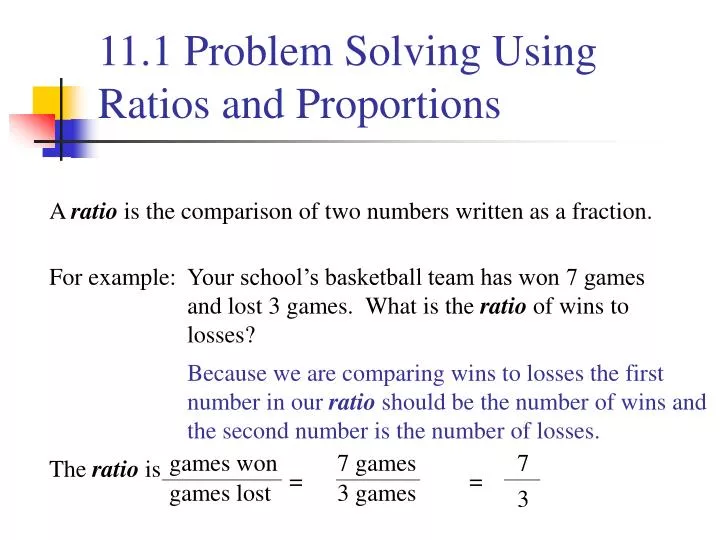
11.1 Problem Solving Using Ratios and Proportions
Jun 29, 2012
580 likes | 1.22k Views
games won. 7 games. 7. games lost. 3 games. 3. 11.1 Problem Solving Using Ratios and Proportions. A ratio is the comparison of two numbers written as a fraction. For example:. Your school’s basketball team has won 7 games and lost 3 games. What is the ratio of wins to losses?.

Share Presentation
- second fraction
- solving rational equations
- extremes means
- basketball team
- use long division

Presentation Transcript
games won 7 games 7 games lost 3 games 3 11.1 Problem Solving Using Ratios and Proportions A ratio is the comparison of two numbers written as a fraction. For example: Your school’s basketball team has won 7 games and lost 3 games. What is the ratio of wins to losses? Because we are comparing wins to losses the first number in our ratio should be the number of wins and the second number is the number of losses. The ratio is = =
120 miles 20 miles 60 gallons 1 gallon 11.1 Problem Solving Using Ratios and Proportions In a ratio, if the numerator and denominator are measured in different units then the ratio is called a rate. A unit rate is a rate per one given unit, like 60 miles per 1 hour. Example: You can travel 120 miles on 60 gallons of gas. What is your fuel efficiency in miles per gallon? Rate = = Your fuel efficiency is 20 miles per gallon.
11.1 Problem Solving Using Ratios and Proportions An equation in which two ratios are equal is called a proportion. A proportion can be written using colon notation like this a:b::c:d or as the more recognizable (and useable) equivalence of two fractions.
11.1 Problem Solving Using Ratios and Proportions When ratios are written in this order, a and d are the extremes, or outside values, of the proportion, and b and c are the means, or middle values, of the proportion. a:b::c:d Extremes Means
11.1 Problem Solving Using Ratios and Proportions To solve problems which require the use of a proportion we can use one of two properties. The reciprocal property of proportions. If two ratios are equal, then their reciprocals are equal. The cross product property of proportions. The product of the extremes equals the product of the means
11.1 Problem Solving Using Ratios and Proportions Solve: x – 1 = 2x 3x – 3 = 2x + 8 x = –1 x = 11
11.1 Problem Solving Using Ratios and Proportions Solve: x2 = -2x - 1 x2 = 2x + 8 x2 + 2x + 1= 0 x2 - 2x – 8 = 0 (x + 1)(x + 1)= 0 (x + 2)(x - 4)= 0 (x + 1) = 0 or (x + 1) = 0 (x + 2) = 0 or (x - 4) = 0 x = -1 x = 4 x = -2
11.2 Problem Solving Using Percents • Percent means per hundred, or parts of 100 • When solving percent problems, convert the percents to decimals before performing the arithmetic operations Is means equals Of means multiplication
11.2 Problem Solving Using Percents • What is 20% of 50? • x = .20 * 50 • x = 10 • 30 is what percent of 50? • 30 = x * 50 • x = 30/50 = .6 = 60%
11.2 Problem Solving Using Percents • 12 is 60% of what? • 12 = .6x • x = 12/.6 = 20 • 40 is what percent of 300? • 40 = x * 300 • x = 40/300 = .133… = 13.33%
11.2 Problem Solving Using Percents • 10 is 30% of what? • 10 = .3x • x = 10/.3 = 33.33 • 60 is what percent of 400? • 60 = x * 400 • x = 60/400 = .15 = 15%
60 10 40 10 11.2 Problem Solving Using Percents • What percent of the region is shaded? 100 is what percent of 2400? 100 = x * 2400? x = 100/2400 x = 4.17%
11.3 Direct and Inverse Variation Direct Variation The following statements are equivalent: • yvaries directly as x. • y is directlyproportional to x. • y=kx for some nonzero constant k. k is the constant of variation or the constant of proportionality
11.3 Direct and Inverse Variation Inverse Variation The following statements are equivalent: • yvaries inversely as x. • y is inverselyproportional to x. • y=k/x for some nonzero constant k.
11.3 Direct and Inverse Variation If yvaries directly asx, then y = kx. If y = 10 when x = 2 , then what is the value of y when x = 8? x and y go together. Therefore, by substitution 10 = k(2). What is the value of k? 10 = 2k 10 = 2k 5 = k
11.3 Direct and Inverse Variation k = 5 Replacing k with 5 gives us y = 5x What is y when x = 8 ? y = 5(8) y = 40
11.3 Direct and Inverse Variation If yvaries inversely asx, then xy = k. If y = 6 when x = 4 , then what is the value of y when x = 8? x and y go together. Therefore, by substitution (6)(4) = k. What is the value of k? 24 = k
11.3 Direct and Inverse Variation k = 24 Replacing k with 24 gives us xy = 24 What is y when x = 8 ? 8y = 24 y = 3
11.3 Direct and Inverse Variation 15 10 5 0 15 20 0 5 10 Direct variation • • y = kx • y = 2x •
11.3 Direct and Inverse Variation 15 10 5 0 15 20 0 5 10 • Inverse Variation xy= k • xy= 16 • • •
11.4 Probability The probability of an event P is the ration of successful outcomes called successes, to the outcome of the event, called possibilities.
11.4 Probability Flipping a coin is an experiment and the possible outcomes are heads (H) or tails (T). One way to picture the outcomes of an experiment is to draw a tree diagram. Each outcome is shown on a separate branch. For example, the outcomes of flipping a coin are H T
11.4 Probability There are 4 possible outcomes when tossing a coin twice. First Toss Second Toss Outcomes H HH H T HT H TH T T TT
11.4 Probability Drawing a card from a deck of 52. P(heart) 13/52 = 1/4 P(red card) 26/52 = 1/2 P(face card) 12/52 = 3/13 P(queen) 4/52 = 1/13
11.4 Probability Possible outcomes for two rolls of a die (1,1) (1,2) (1,3) (1,4) (1,5) (1,6) (2,1) (2,2) (2,3) (2,4) (2,5) (2,6) (3,1) (3,2) (3,3) (3,4) (3,5) (3,6) (4,1) (4,2) (4,3) (4,4) (4,5) (4,6) (5,1) (5,2) (5,3) (5,4) (5,5) (5,6) (6,1) (6,2) (6,3) (6,4) (6,5) (6,6)
Find the following probabilities • 1/36 • 2/36 • 3/36 • 4/36 • 5/36 • 6/36 • 5/36 • 4/36 • 3/36 • 2/36 • 1/36 • Find the probability that the sum is a 2 • Find the probability that the sum is a 3 • Find the probability that the sum is a 4 • Find the probability that the sum is a 5 • Find the probability that the sum is a 6 • Find the probability that the sum is a 7 • Find the probability that the sum is a 8 • Find the probability that the sum is a 9 • Find the probability that the sum is a 10 • Find the probability that the sum is a 11 • Find the probability that the sum is a 12
11.5 Simplifying Rational Expressions • Define a rational expression. • Determine the domain of a rational function. • Simplify rational expressions.
11.5 Simplifying Rational Expressions • Rational numbers are numbers that can be written as fractions. • Rational expressions are algebraic fractions of the form P(x) , where P(x)and Q(x) Q(x) are polynomials and Q(x) does not equal zero. • Example:
11.5 Simplifying Rational Expressions • P(x) ; Since division by zero is not Q(x) possible, Q(x) cannot equal zero. • The domain of a function is all possible values of x. • For the example , 4x + 1 ≠ 0 so x ≠ -1/4.
11.5 Simplifying Rational Expressions • The domain of is all real numbers except -1/4. • Domain = {x|x ≠ -1/4}
11.5 Simplifying Rational Expressions • Find domain of • Solve: x2 –5x – 6 =0 (x – 6)(x + 1) = 0 The excluded values are x = 6, -1 • Domain = {x|x ≠-1, 6}
11.5 Simplifying Rational Expressions • To simplify rational expressions, factor the numerator and denominator completely. Then reduce. • Simplify:
11.5 Simplifying Rational Expressions Factor: Reduce: 2
11.5 Simplifying Rational Expressions Simplify: Factor –1 out of the denominator:
11.5 Simplifying Rational Expressions Reduce:
11.5 Simplifying Rational Expressions • Multiply rational expressions. • Divide rational expressions
11.5 Simplifying Rational Expressions • To multiply, factor each numerator and denominator completely. • Reduce • Multiply the numerators and multiply the denominators. • Multiply:
11.5 Simplifying Rational Expressions Factor: 5 Reduce:
11.5 Multiplying and Dividing Multiply:
11.6 Multiplying and Dividing • To divide, change the problem to multiplication by writing the reciprocal of the divisor. • (Change to multiplication and flip the second fraction.) • Divide:
11.5 Multiplying and Dividing Change to multiplication: Factor completely:
11.5 Multiplying and Dividing Reduce: Multiply:
11.7 Dividing Polynomials Dividing a Polynomial by a Monomial Let u, v, and w be real numbers, variables or algebraic expressions such that w≠ 0.
11.7 Dividing Polynomials
11.7 Dividing Polynomials Use Long Division x + 6 Note: (x + 6) (x – 2) = x2 + 4x - 12 x2 -2x 6x - 12 6x - 12 0
11.7 Dividing Polynomials Use Long Division x + 5 x2 - x 5x - 1 5x - 5 4
11.7 Dividing Polynomials Note: x2 term is missing x2 - 2x + 6 x3 + 2x2 - -2x2 + 2x -2x2 – 4x 6x - 1 6x + 12 - -13
11.8 Solving Rational Equations LCD: 2x Multiply each fraction through by the LCD Check your solution!
- More by User

Ratios and proportions
Developer Page. Developer MaterialsLesson OverviewStandardsFormative AssessmentOpening LessonDeveloping LessonClosing Lesson. Student MaterialsIntroductionLearning GoalsAssessmentLearning ActivityEnrichment. Lesson Overview. This lesson is used as in introduction to the unit of ratios and
380 views • 15 slides
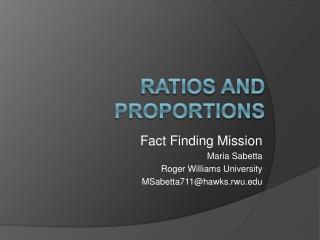
Ratios and Proportions
Fact Finding Mission Maria Sabetta Roger Williams University [email protected]. Ratios and Proportions. Developer Page. Developer Materials Overview Resources and Credits Student Materials Your Search Student Worksheet Your Questions The Big Question. Overview.
367 views • 11 slides

Ratios and proportions. Definitions. Ratio : is a comparison of two numbers by division. Example: x to y; x:y; x/y or x divided by y Means-Extremes Property of Proportions : In a proportion, the product of extremes is equal to the product of the means.
233 views • 5 slides
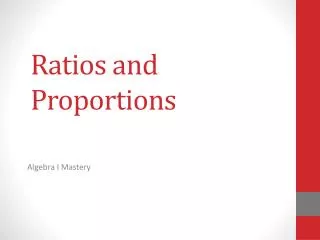
Ratios and Proportions. Algebra I Mastery. There’s lots of differences between the classes in your school – … Some have more boys than girls … Less USC fans than Clemson fans … More cat-lovers than dog-lovers … Less pizza- munchers than chicken-dippers.
301 views • 16 slides

Using Ratios and Proportions
Using Ratios and Proportions . Section 6.1. Do Now: pg 354 (1-10). Vocabulary. Using Ratios and Proportions . What You'll Learn. You will learn to use ratios and proportions to solve problems. 1) ratio 2) proportion 3) cross products 4) extremes 5) Means
382 views • 13 slides
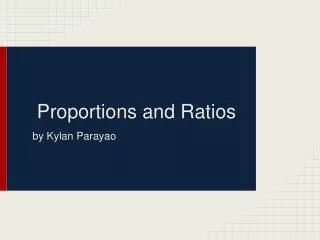
Proportions and Ratios
Proportions and Ratios. by Kylan Parayao. Vocabulary and Examples . Ratio : A comparison of two numbers or quantities Numerical Example : 1 apple : 3 oranges This ratio compares apples to oranges. It means for every apple there are 3 oranges. Algebraic Example: A /B
314 views • 9 slides

Ratios and Proportions. Ratios. Ratio – a comparison of two quantities or numbers Examples : The ratio of boys to girls The ratio of students to teachers The ratio of red marbles to blue marbles Ratios are written 3 ways: a , a:b , a to b
184 views • 6 slides

Solving Story Problems with Ratios and Proportions
Solving Story Problems with Ratios and Proportions. Example #1 The manufacturing company needs to produce 4,675 batteries for a certain cell phone in 5 business days. How many batteries should be completed after 2 business days?. 1870 batteries should be finished by the end of the second day.
149 views • 5 slides

Ratios and Proportions. Warm Up - Simplify. Ratio – comparison of two numbers by division. Proportion – an equation stating that two ratios are equal. Ratio. # boys to # girls # boys : # girls. Ratios are equal if the cross products are equal. Solve. Solve.
352 views • 16 slides
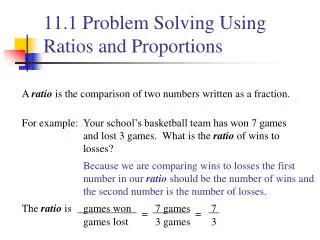
11.1 Problem Solving Using Ratios and Proportions. A ratio is the comparison of two numbers written as a fraction. For example:. Your school’s basketball team has won 7 games and lost 3 games. What is the ratio of wins to losses?.
1.22k views • 48 slides
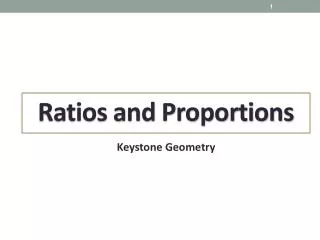
Keystone Geometry. Ratios and Proportions. Ratio. A ratio is a comparison of two numbers such as a : b. Ratio:. When writing a ratio, always express it in simplest form. ** Ratios must be compared using the same units. A ration can be expressed: 1. As a fraction
399 views • 14 slides

Simplify each ratio. 1. 2. 3. 4. 5. 20:30 6. 8 to 2 7. 2 to 8 8. 12 : 9 9. Draw a triangle. Then draw its three midsegments to form a smaller triangle. How do the lengths of the sides of the smaller triangle compare to the lengths of the sides of the larger triangle?. 2 4. 8
291 views • 14 slides
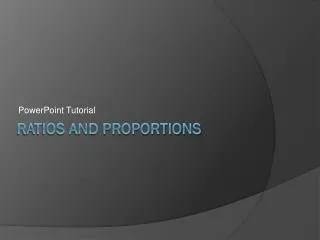
PowerPoint Tutorial. Ratios and Proportions. Overview…. In this tutorial you will learn about ratios and proportions. The main goals are… for you to really understand what the term “per” means …and… to understand that one variable can be mathematically related to another.
301 views • 15 slides

Keystone Geometry. Ratios and Proportions. Ratio. A ratio is a comparison of two numbers such as a : b. Ratio:. When writing a ratio, always express it in simplest form. ** Ratios must be compared using the same units. A ratio can be expressed: 1. As a fraction
507 views • 14 slides

Ratios and Proportions. Created by: Mrs. J Couch. Ratio. A ratio is a comparison of two numbers or quantities. part to part part to whole whole to part A ratio can be expressed three ways : Using the fraction bar as in ⅔ Using a colon symbol as in 2:3
347 views • 16 slides

Ratios and Proportions. Grades 6/7. Sara Anaya Ayşe Şahin Diana White. An example of how to introduce the notion of a ratio: Illustrative Mathematics 6.RP.1 Task example: Games at recess. 6.RP.1: The language of ratio and proportion.
243 views • 14 slides

Ratios and proportions. Section 7.0. There are 6 boys and 3 girls in a class. Find the ratio of: Boys to girls Girls to boys Boys to children Children to girls There are 8 oranges, 9 grapes and 3 carrots in a basket. Find the ratio of: Orange to grapes Carrots to grapes
185 views • 7 slides

Ratios and Proportions. A ratio is a comparison of like quantities. A ratio can be expressed as a fraction or in ratio notation (using a colon). One common use is to express the number of parts of one substance contained in a known number of parts of another substance. 1.
488 views • 25 slides

Ratios and Proportions. Created By: Mr. Kornfield. Terms. Ratios compare two numbers. Ex. of a ratio 1gal of gas : $3 Ex. of a proportion 5ft. : 50ft. = 1ft. : 10ft. Ratios also look like fractions, but it means the same 1/3 5/50 1/10. Terms Cont.
241 views • 6 slides
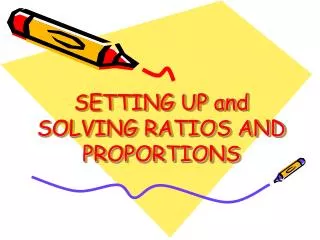
SETTING UP and SOLVING RATIOS AND PROPORTIONS
SETTING UP and SOLVING RATIOS AND PROPORTIONS. Ratio – Comparison of 2 numbers by division. Ex. 1:2, ½, 1 to 2 Proportion – An equation stating that 2 ratios are equal. a:b = c:d Extremes – The last (or end) terms of a proportion. a and d are the extremes
335 views • 15 slides

Ratios and Proportions. dp. 100 cd. 100 dp. 100 c. p. c. Ratios and Proportions. If p pencils cost c cents, how many pencils can be bought for d dollars ? cdp b) 100 cdp c) d) e). 1. 1. 27. 3. Ratios and Proportions.
260 views • 11 slides

Ratios and Proportions. Geometry. Ratios. Writing Ratios. Ratios. What are some examples of ratios used in real-life?. Real-World Example.
236 views • 20 slides

IMAGES
COMMENTS
MCC6.RP.3 Use ratio and rate reasoning to solve real-world and mathematical problems, e.g. by reasoning about tables of equivalent ratios, tape diagrams, double number line diagrams, or...
Unit Two: Ratios and Proportions. 3 of 107. Standards. Understand ratio concepts and use ratio reasoning to solve problems. MCC6.RP.1 Understand the concept of a ratio and use ratio...
Key points covered include: writing ratios in lowest terms, setting up cross multiplication to solve proportions, and using variables like n as unknowns to solve for in proportions. This document discusses ratios, rates, proportions, and how to use them to solve real-life problems.
Math 6 - Solving Problems Involving Ratio. This document contains several ratio word problems and their corresponding learning targets. Specifically: 1) It asks the reader to find values for n given specific ratios. 2) It asks the reader to determine which of two ratios is greater.
It provides examples of setting up and solving ratios and proportions. Key points covered include: writing ratios in lowest terms, setting up cross multiplication to solve proportions, and using variables like n as unknowns to solve for in proportions.
Use tables to compare ratios. 6.RP.3b Solve unit rate problems including those involving unit pricing and constant speed. For example, if it took 7 hours to mow 4 lawns, then at that rate, how many lawns could be mowed in 35 hours? At what rate were lawns being mowed?
• In this lesson, you will learn about ratios in geometry and review techniques you can use to solve geometric and real-life problems with ratios. Vocabulary • Ratio a to b • If a and b are two quantities that are measured in the same units, then the ratio of “a to b” is or a : b.
Main PowerPoint covers all aspects of ratio and proportion for GCSE (but not direct and inverse proportion): relationship between fractions and ratios; dividing an amount in a ratio - inc finding the total amount and solving problems from the difference between two shares; simplifying ratios by converting units; expressing as 1:n; working with ...
11.1 Problem Solving Using Ratios and Proportions An equation in which two ratios are equal is called a proportion. A proportion can be written using colon notation like this a:b::c:d or as the more recognizable (and useable) equivalence of two fractions.
Introduce ratios to your students using this fun Sixth Grade Introduction to Ratios PowerPoint & Google Slides! The presentation includes direct instruction as well as numerous review points and opportunities to test their knowledge!